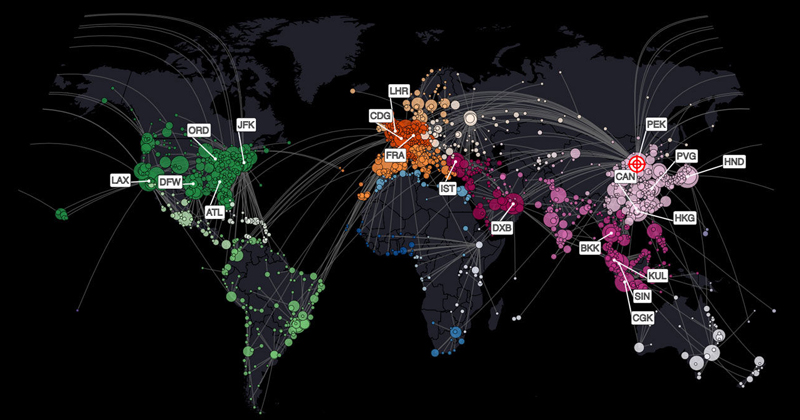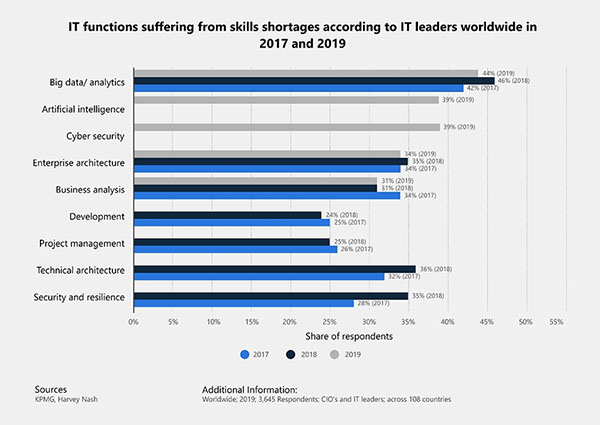
Location: Chengdu Station China
Task: Detect Passengers infected with Coronavirus
Staring at a screen displaying infrared pictures of passengers’ body temperatures, he said: “This is making my life much easier... Before this, I'd have to test everyone's temperature with an ear thermometer. And sometimes that doesn't work - I think this new system is much better.”
China has contained Coronavirus. Thanks to Big Data.
On other occasions, we may have debated the ethicality of collecting and using people’s personal data for public gains, but right now we are compelled to compliment it. While this unbelievable barricade may be easy for China, it can be a tough nut to crack for others.
This phenomenal success has left us wondering - is there any problem that Big Data cannot solve? With each passing day, it is showing promises in the most unexpected places. While we eagerly wait for its bigger contribution in containing the pandemic, here are three business use cases where it has proved its worth.
Walmart- The First Mover’s AdvantageWalmart employs two million employees across 28 countries in 20,000 stores rooting itself as the world’s largest retailer with recorded highest revenues. A significant credit of this sprawl goes to the first mover’s advantage that the big blue-chip cashed in by employing big data right from the beginning from 2012.
The retail giant is forging the world’s largest private cloud that can handle 2.5 petabytes of data/ hour. Its Data Café in Bentonville, Arkansas, is a state-of-the-art analytics hub remodelling, restructuring and visualizing 40 petabytes of transactional data in real-time.
Gushing over the benefits of sifting data speedily, its analyst Naveen Peddamail said:
“If you can’t get insights until you’ve analysed your sales for a week or a month, then you’ve lost sales within that time.”
Peddamail explained further how they used Big Data to analyze plummeting sales of a grocery item. Data analysis led them to pricing miscalculations in the product which was listed at a much higher price than required. Without Big Data, the bug would have gone undetected.
Walmart is gnawing on Big Data in an unprecedented way. Aside from discovering user shopping patterns, and providing personalized product recommendations to consumers, it uses the insights for an array of activities: finding prescriptions filled in a day, analyzing busiest business periods, improving checkout experience, tracking the number of steps from the dock to the store, and customer shopping preferences. Its super-vigilant system is tuned to raise alerts when assigned metrics fall below a particular threshold. In a recent Halloween sale, demand for a type of cookies shot up in one store while slumped in the other two. Big Data pulled this deviation and proffered that the cookies weren’t stacked appropriately in stores.
Walmart’s Café can pull in and churn a wide array of information, including but not limited to “economic data, Nielsen data, meteorological data, local events databases, social media data, gas prices, and telecom data.”
Big Data helped Walmart grow its assortments from 700,000 items in 2011 to 60,000,000 in 2017.
Uber- Cashing on ConnectionsUber has upended the start-up equation. It ate up the commuting world in few years. But only a few know that while Uber drove people, data drove Uber. From calculating surge prices, arriving at ride prices, pinning fake ratings and fake rides to finding the best route, Uber is all about data. Take data aside from Uber and we are left with a run-of-the-mill app that any rookie can launch.
The burgeoning start-up replicated the air transport price optimization model and gained heavily on it. Be it forecasting peak demand or analyzing traffic bottlenecks, Uber’s algorithm does it all at a lightning speed. On average, it takes 15 seconds to match a driver.
One attribute that competitors fail to copy from it is the ability to build connections. Uber’s model shows why data shouldn’t be applied in a blanket-like fashion.
“Uber lives or dies by data. Their overall mission and their sustainability is completely dependent on how good their data is. The more data they can collect, the more information they can derive from patterns and behaviours. Their ability to increase profits is all dependent on that.”- Spencer, a former Uber driver.
Uber never sleeps. Even when drivers are not carrying passengers they are adding traffic information to Uber’s data bank. Uber has shown us that one simple innovation can change the way we work and live. Its services are now helping ease out traffic congestion and pollution woes.
Netflix- The Devil lives in DetailsNetflix has washed out its competitors and is extirpating other related businesses too. With a 93% customer retention rate, the giant retains a substantial chunk of its 151 million subscribers and beats Disney as the “world’s most valued media company.” While we may like to credit the brand for phenomenal success, true credit goes to Big Data.
Netflix’s success is attributed to its understanding of its subscribers. On how well it knows and analyses its customer’s buying behaviour and patterns.
75% of its traffic comes from the recommendations by its algorithm. What device you are using, when you paused, when you watch it and what you watch in it, do you go back to it after pausing the show, how long do you take to go back, which scenes you replayed, what ratings you gave?- Netflix knows this and more and uses the information for its future offerings.
“There are 33 million versions of Netflix.”- Joris Evers, Director of Global CommunicationsThe number may have stuck as baffling but no guess or probability game going on here. With data backing its every move, Network launches bulls-eye shots, every single time. It was assured about the success of “Orange is the new Black” because “Weeds” was successful. It even matches the ads its shows to the kind of content you watch.
Result - It saves USD 1billion every year by retaining its customers with the help of big data and predictive analytics.
A War for Data Science Skills:Businesses now know Big Data’s worth. 97% of companies worldwide are investing in AI and Big Data
While these late arrivers scram through the skimpy skill market, they further push Big data and analytics demand to the unrealistic stratosphere.
46% of CIOs say it is excessively difficult to find skilled big data professionals. –KPMG CIO Survey

Biggest Skill Shortage in the Domain of Big Data/Analytics
This demand-supply gap will widen in times to come. While it heralds difficult days ahead for employers, it also beckons rife and easy-to-grab career opportunities for fresh graduates and young professionals.
Getting certified is the quickest way to hop in this ship to the future world of profound promises.
By 2023, revenues from big data and business analytics will touch USD 210 billion, securing a CAGR of 12%. The era of informed decisions is here. Are you ready?
































